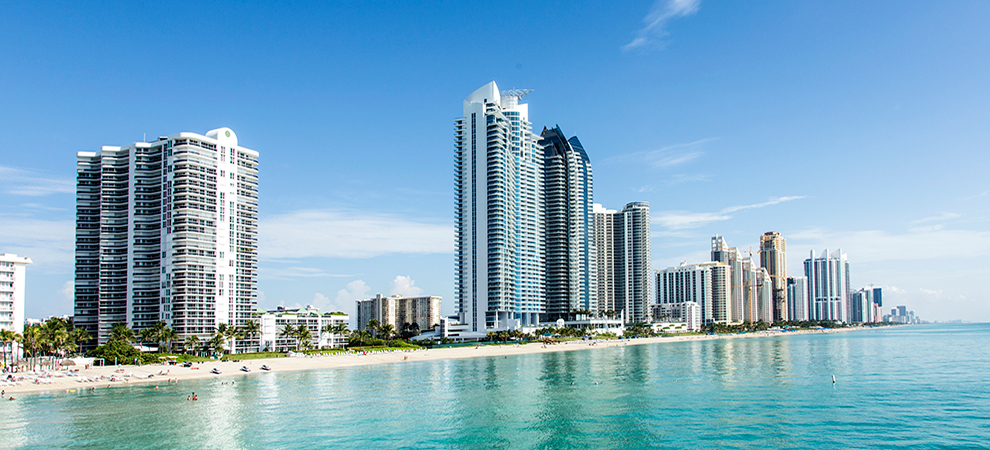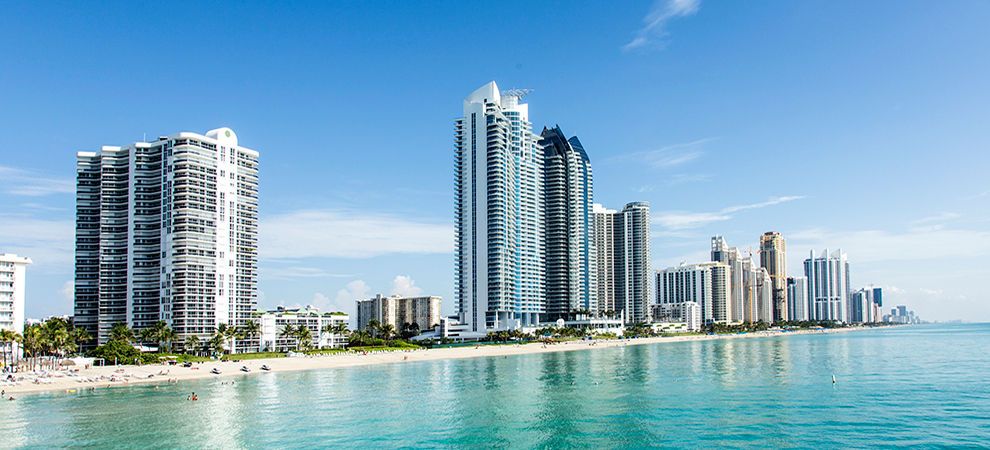
Home Sales Continue to Rise, Yet Condo Sale Continue to Slide in April
According to a new report by the Miami Association of Realtors, Miami single-family home sales, median prices, traditional transactions and dollar volume increased year-over-year in April 2017.
Single-family home sales in Miami expanded 3.7 percent year-over-year in April, from 1,150 to 1,192. Single-family luxury sales (up 56.5 percent) and median prices (up 12.3 percent to $320,000) rose by double figures. Single-family traditional sales (up 15.1 percent) and dollar volume (up 22.7 percent to $603.6 million) also registered increases.
"April's statistical report points to positive market expansion for Miami real estate," said Coral Gables Realtor Christopher Zoller, the 2017 MIAMI chairman of the board. "A lack of local buildable land puts high value and demand for existing Miami single-family homes. Existing condominiums, meanwhile, have seen five-plus years of price appreciation."
According to Freddie Mac, the average commitment rate for a 30-year, conventional, fixed-rate mortgage declined for the first time in six months, dipping to 4.05 percent in April from 4.20 percent in March. The average commitment rate for all of 2016 was 3.65 percent.
Total Sales Decline But Remain in Line with Historical Averages
Total existing Miami-Dade County residential sales -- which posted a record year in 2013 and near record years in 2014 and 2015 -- decreased 4.8 percent year-over-year from 2,419 to 2,303.
Sales for existing condominiums, which are competing with a robust new construction market, declined 12.5 percent year-over-year. A shortage of existing condo properties at popular price points impacted sales.
The lack of access to mortgage loans is also impacting the existing condominium market. Of the 9,307 condominium buildings in Miami-Dade and Broward Counties, only 12 are approved for Federal Housing Administration loans, down from 29 last year, according to Florida Department of Business and Professional Regulation and FHA.
The rise in Miami single-family home sales is being led by a surge in mid-market transactions. Miami single-family mid-market home sales, or transactions for properties listed between $200,000 and $600,000, jumped 13.2 percent in April, from 725 to 821 sales. Mid-market home sales comprise 68.9 percent of all single-family home sales.
Luxury single-family sales ($1 million and above) jumped 56.5 percent, from 62 to 97.
Miami single-family traditional sales, or non-distressed transactions, rose 15.1 percent. This growth in traditional sales, from 933 to 1,074 transactions, shows the health and strength of the Miami market.
Total sales volume for all properties accounted for $1.01 billion last month. These sales do not include Miami's multi-billion dollar new construction condo market.
Median Prices Rise for All Properties
Miami-Dade County single-family home prices jumped 3.7 percent in April 2017, increasing from $285,000 to $320,000. Miami single-family home prices have now risen for 65 consecutive months, a streak spanning more than five years. Existing condo prices increased 6.5 percent, from $215,000 to $229,000. Condo prices have increased in 69 of the last 71 months.
Despite the rise in prices, Miami real estate remains a major bargain. A 120-square meter condominium in Miami-Fort Lauderdale-Miami Beach cost $170,000 in 2016 Q3, according to the National Association of Realtors (NAR). The average cost of a 120-square meter apartment in 2016 in the prime inner city areas of London ($4.1 million), Hong Kong ($3.1 million), and New York ($2.2 million) were at least ten times higher, according to Global Property Guide.
Miami Distressed Sales Continue to Drop
Total Miami distressed sales declined 43.5 percent year-over-year, from 409 to 231 last month. Only 10 percent of all closed residential sales in Miami were distressed last month, including REO (bank-owned properties) and short sales, compared to 16.9 percent in April 2016. In 2009, distressed sales comprised 70 percent of Miami sales.
Short sales and REOs accounted for 2.3 and 3.2 percent, respectively, of total Miami sales in April 2017. Short sale transactions dropped 27.4 percent year-over-year while REOs fell 47.0 percent.
Nationally, distressed sales accounted for 5 percent of sales in April, down from 7 percent a year ago.
Miami Real Estate Selling Close to List Price
The median number of days between listing and contract dates for Miami single-family home sales was 49 days, an 8.9 percent increase from 45 days last year. The median number of days between the listing date and closing date for single-family properties increased 7.4 percent to 101 days.
For condos, the median time to contract increased 15.2 percent to 76 days. The median number of days between the listing date and closing date increased 8.2 percent to 119 days.
The median percent of original list price received for single-family homes decreased 0.7 percent to 95.1 percent. The median percent of original list price received for existing condominiums decreased 0.3 percent to 93.6 percent.
National and State Statistics
Nationally, total existing-home sales dipped 2.3 percent to a seasonally adjusted annual rate of 5.57 million in April from a downwardly revised 5.70 million in March.
Statewide closed sales of existing single-family homes totaled 23,829 last month, easing slightly (-1.2 percent) when compared to April 2016, according to Florida Realtors. Statewide closed condo sales totaled 10,292 last month, down 4 percent compared to April 2016.
The national median existing-home price for all housing types in April was $244,800, up 6.0 percent from April 2016 ($230,900). April's price increase marks the 62nd straight month of year-over-year gains.
The statewide median sales price for single-family existing homes last month was $234,900, up 10.3 percent from the previous year, according to Florida Realtors. The statewide median price for townhouse-condo properties in April was $172,000, up 7.2 percent over the year-ago figure. April was the 65th month in a row that statewide median prices for both sectors rose year-over-year.
Miami's Cash Buyers Represent Almost Double the National Figure
Miami cash transactions comprised 39.4 percent of April total closed sales, compared to 48.6 percent last year. Miami cash transactions are almost double the national figure (21 percent). Miami's high percentage of cash sales reflects South Florida's ability to attract a diverse number of international home buyers, who tend to purchase properties in all cash.
Condominiums comprise a large portion of Miami's cash purchases as 55.3 percent of condo closings were made in cash in April compared to 24.7 percent of single-family home sales.
Seller's Market for Single-Family Homes, Buyer's Market for Condos
Inventory of single-family homes decreased 2.2 percent in April from 6,320 active listings last year to 6,182 last month. Condominium inventory increased 9.2 percent to 15,307 from 14,011 listings during the same period in 2016.
Single-family homes have a 5.6-month supply, which indicates a seller's market. Existing condominiums have a 13.8-month supply, which indicates a buyer's market. A balanced market between buyers and sellers offers between six and nine months supply of inventory.
Total active listings at the end of March increased 5.7 percent year-over-year, from 20,331 to 21,489, Active listings remain about 60 percent below 2008 levels when sales bottomed. New listings of Miami single-family homes decreased 9.6 percent, from 1,803 to 1,630. New listings of condominiums decreased 13.0 percent, from 2,503 to 2,177.
Nationally, total housing inventory at the end of April climbed 7.2 percent to 1.93 million existing homes available for sale, but is still 9.0 percent lower than a year ago (2.12 million) and has fallen year-over-year for 23 consecutive months. Unsold inventory is at a 4.2-month supply at the current sales pace, which is down from 4.6 months a year ago.
New Construction Market Update
Most Miami preconstruction condo developers require a 50-percent cash deposit on new units. The deposit is not only one of the highest in the United States but is significantly higher than the 20 percent required during the last real estate cycle. The large cash deposits show how committed Miami's preconstruction condo buyers are to the local market.
Eighty-one condo towers with 8,007 units have been completed in Miami-Dade County east of I-95 in the last six years since the start of 2011, according to a May 23 report from preconstruction condo projects website Cranespotters.com and MIAMI.
Partner source : https://shar.es/1RvGjz
World property journal


